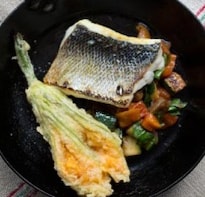Equipment: The sharpest blade and any tweezers
You need a sharp filleting knife. We use Victorinox knives with black plastic handles and a seven-inch blade (for bigger fish such as salmon you might need a longer blade). They're thin and quite flexible so you can cut around the ribcage without losing any flesh.You'll also need some fish tweezers to take out the pin bones - but tweezers will do: at home I use my wife's tweezers when she's not looking.Step One: Remove scales
Your fishmonger will usually remove the scales. If not, scrape them off from tail to head using the blunt edge of the knife, held at a slight angle. Go easy, so they don't go all over the place, and watch out for the spines. Make sure you get all the scales off on both sides - if you don't, the knife could slip and cut your fingers when you're filleting. Then run the fish under cold water and pat dry with kitchen roll.Advertisement
Step Two: Cut along the body
From the incision you've made at the head, bring the knife all the way along the back bone to the tail, keeping the blade as close to the spine as possible. Make sure you glide the knife, don't saw.Step Three: Remove the fillet
At this stage, if you're filleting sea bass or gurnard, you'll encounter a small difficulty: the rib cage (at the head end of the fillet) bulges out a bit. You need to break it by sliding the knife down with a bit of force, while lifting the flesh gently with your other hand. Once it's broken, you can remove the fillet easily from the body by cutting along the bottom.Step Four: Trim and tidy
Lay the fillet down separately and trim around it, cutting away the skin and fat you're not going to eat.Advertisement
Step Five: Repeat the process
Turn the fish over and repeat the process. This side is always a little harder because you've lost some support. When cutting along the body, I tend to start from the tail end. When you've taken both fillets, remove the guts and use the carcass to make fish stock or soup.Step six: Time for tweezers
Finally, take out the pin bones from each fillet using tweezers. You'll find the bones running along the middle of the fillet at the head end. Sea bass usually have five or six but you'll find more in a bigger fish such as salmon. The fresher the fish, the harder it is to get them out.Now try these recipes ...Sea bass tartare with avocado, chilli, cucumber and coriander
Serves 4-6sea bass fillet (preferably line-caught) 600g
limes 3 (1 for garnish)
medium-sized red onion 1, peeled and finely sliced
cucumber ½ peeled, halved and thinly sliced
ripe avocado 1, diced into 1cm pieces
mild small red chilli 1, seeded and finely chopped
extra virgin olive oil 30ml
coriander ½ small bunch, roughly chopped
sea salt and freshly ground black pepper
Advertisement
We serve this in the Oyster Bar with grilled bread or crisp olive bread.
Sea bass with slow-roasted summer vegetables and fried courgette flower
Serves 4red peppers 2
extra virgin olive oil for cooking
courgettes 2, cut into 2cm cubes
aubergine 1, cut into 2cm cubes
medium-sized red onion 1, peeled and roughly chopped
garlic 2 cloves, peeled and crushed
fresh oregano 4 sprigs, chopped
white wine 100ml
tomato passata sauce 200ml
good quality pitted green olives 100g, sliced in half
basil ½ small bunch, finely chopped
salt and freshly ground black pepper
whole sea bass, scaled, filleted and pin-boned (preferably line caught) 1.5kg, cut into 4 portions For the batter for fried courgette flowers
iced water
tempura flour (available from Chinese and Japanese stores) 150ml
sunflower oil for frying
courgette flowers 4 (available from farmers' markets or grow your own)Lightly coat the red peppers in olive oil and put under the grill at high heat until the skin is blackened on all sides. Place in a bowl, cover with clingfilm and leave to cool. Once cooled, remove the skins, cut in half, take out the seeds and cut into 2cm dice.
Heat a good splash of olive oil in a heavy-bottomed hot pan, and add the courgettes and aubergine in small batches until lightly golden. Remove from the pan. Wipe out pan with kitchen paper. Add another splash of olive oil and fry the red onions, garlic and oregano until soft. Add the white wine and reduce by half. Add the passata and reduce by half again. Then add the red peppers, courgettes, aubergine, olives and basil. Check the seasoning and keep to one side.
Make the batter for the fried courgette flowers by slowly adding the iced water to the tempura flour in a large bowl. Whisk continuously until you get a pouring cream consistency. Season and leave to one side.
Finally, heat a non-stick frying pan. Add a splash of olive oil. Season the sea bass fillets and gently cook skin-side down for 5 minutes. Turn over and cook for a further 4 minutes.
During this time, pour 6cm of sunflower oil into a medium-sized, heavy-bottomed saucepan or a deep-fat fryer. Heat to 160C. If using a saucepan, please be careful as the oil will be very hot. Dip the courgette flowers into the tempura batter, shaking off any excess batter, and gently fry them in small batches until golden brown. Remove with tongs and place on kitchen paper to soak up any excess oil. Season if necessary.
To serve, reheat the vegetables; put a good spoonful on to each plate. Place the sea bass on top and finish with the courgette flower.
Advertisement
For the latest food news, health tips and recipes, like us on Facebook or follow us on Twitter and YouTube.
Advertisement
Tags:
